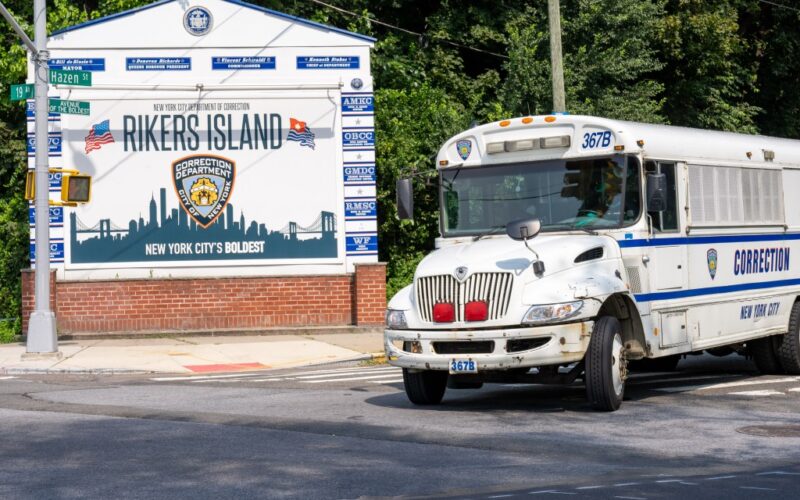New York City spends more than $2.8 billion a year to prop up Rikers — a failing, decrepit jail complex that delivers none of the outcomes we need. Closing Rikers is the law and is absolutely necessary. The question is whether our current and future elected leaders will show the urgency and political will to fund the investments we need to shut it down. That must start with the city budget, due by June 30.
Rikers is a public safety, fiscal, and moral failure. Rikers isn’t stopping crime or rehabilitating people. It’s not delivering justice. At $400,000 per person per year, it provides an atrocious return on investment. One in three people released from Rikers are back on Rikers within a year. More than 60 people held on Rikers have died since 2020, including two last week. Rikers’ buildings are crumbling, leaking sewage, and supplying rusty metal and broken plexiglass for weapons.
That’s why, in March 2025, the Independent Rikers Commission released A Path Forward: The Blueprint to Close Rikers. A pragmatic, data-backed plan rooted in what works, the blueprint outlines how NYC can safely implement each step necessary to close Rikers.
First, we must safely end the artificial inflation of the jail population, which is thousands higher than necessary for public safety. Rikers is the second-largest psychiatric facility in the country, including 900 people a year so severely mentally ill they cannot understand what’s happening in court.
No one wins by subjecting people with serious mental illness to months and years of violence and dysfunction on Rikers, then releasing them back into our communities, often without adequate support. Adding 500 secure psychiatric hospital beds outside the jails, and investing in proven community-based mental health housing and treatment will stabilize people, reduce crime, and slash the jail population.
Rikers is primarily a pretrial facility, but cases need to move more quickly. Victims wait for answers and accountability. A major initiative by the state Office of Court Administration to speed up cases holds the promise of reducing the jail population by up to 2,000 people. Safely reducing the jail population will also help staff get a grip on violence and better deliver treatment and rehabilitation.
Once Rikers is replaced by the new borough-based jails and secure hospital beds already underway, taxpayers will save more than $2 billion per year in operating costs.
The task is for New York’s leaders to deliver on these solutions.
Yet, there’s been renewed noise about “revisiting” the plan to close Rikers. Every alternative thrown out to date will cost billions more and take a decade longer than the current plan. Meanwhile, staff and incarcerated people — who are 85% and 89% Black and Latino respectively — will be subjected to dangerous conditions. We’ll all continue to feel the ugly ripple effects of Rikers on our streets and subways. That wouldn’t just be irresponsible and fiscally reckless. It’s indefensible.
We fail past and potential crime victims by pouring inordinate sums into Rikers’ accelerator of human misery, yet not spending pennies on the dollar to stop the pain before it begins. Our 2024 citywide survey of crime survivors showed this clearly: victims overwhelmingly support investing in treatment, accountability, and prevention over incarceration on Rikers.
The City Council understands this and has taken up our commission’s call to increase critical funding. But the mayor hasn’t yet invested in the essential infrastructure required to break the cycle of crime, incarceration, and recidivism. I urge the mayor, an avowed proponent of closing Rikers since his days as Brooklyn borough president, to make those investments now when they mean the most. Otherwise, the city can’t and won’t meet its stated goals of sharply reducing crime and incarceration.
The present situation is untenable for the future health and safety of the city:
New supportive housing for homeless New Yorkers with serious mental illness cycling in and out of jail? Unfunded.
Additional treatment beds for people with co-occurring addiction and serious mental illness? Unfunded.
Ensuring everyone leaving Rikers has a reentry plan — a fundamental public safety tool. Unfunded.
Any argument that New Yorkers can’t afford these investments — even with looming federal cuts — collapses under the weight of a $2.8 billion annual Rikers budget. This is about the political will to build a system that actually delivers safety, justice and accountability.
We have the public and legal mandate to close Rikers. The blueprint has been carefully created. Now we need the leadership and funding. Our elected leaders — current and future — must act.
Lippman, a former New York State chief judge, is chair of the Independent Rikers Commission.








